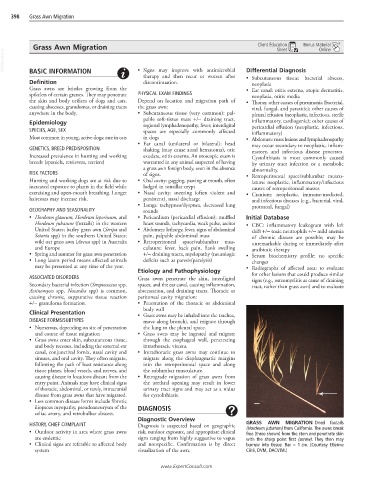Page 834 - Cote clinical veterinary advisor dogs and cats 4th
P. 834
398 Grass Awn Migration
Grass Awn Migration Client Education Bonus Material
Sheet
Online
VetBooks.ir
BASIC INFORMATION
• Signs may improve with antimicrobial
therapy and then recur or worsen after Differential Diagnosis
• Subcutaneous tissue: bacterial abscess,
Definition discontinuation. neoplasia
Grass awns are bristles growing from the • Ear canal: otitis externa, atopic dermatitis,
spikelets of certain grasses. They may penetrate PHYSICAL EXAM FINDINGS neoplasia, otitis media
the skin and body orifices of dogs and cats, Depend on location and migration path of • Thorax: other causes of pneumonia (bacterial,
causing abscesses, granulomas, or draining tracts the grass awn: viral, fungal, and parasitic); other causes of
anywhere in the body. • Subcutaneous tissue (very common): pal- pleural effusion (neoplastic, infectious, sterile
pable soft-tissue mass +/− draining tract,
Epidemiology regional lymphadenopathy, fever; interdigital inflammatory, cardiogenic); other causes of
SPECIES, AGE, SEX spaces are especially commonly affected pericardial effusion (neoplastic, infectious,
inflammatory)
Most common in young, active dogs; rare in cats in dogs • Abdomen: mass lesions and lymphadenopathy
• Ear canal (unilateral or bilateral): head may occur secondary to neoplastic, inflam-
GENETICS, BREED PREDISPOSITION shaking (may cause aural hematoma), otic matory, and infectious disease processes.
Increased prevalence in hunting and working exudate, otitis externa. An otoscopic exam is Cystolithiasis is most commonly caused
breeds (spaniels, retrievers, terriers) warranted in any animal suspected of having by urinary tract infection or a metabolic
a grass awn foreign body, even in the absence abnormality.
RISK FACTORS of signs. • Retroperitoneal space/sublumbar muscu-
Hunting and working dogs are at risk due to • Oral cavity: gagging, pawing at mouth, often lature: neoplastic, inflammatory/infectious
increased exposure to plants in the field while lodged in tonsillar crypt causes of retroperitoneal masses
exercising and open-mouth breathing. Longer • Nasal cavity: sneezing (often violent and • Cranium: neoplastic, immune-mediated,
haircoats may increase risk. persistent), nasal discharge and infectious diseases (e.g., bacterial, viral,
• Lungs: tachypnea/dyspnea, decreased lung protozoal, fungal)
GEOGRAPHY AND SEASONALITY sounds
• Hordeum glaucum, Hordeum leporinum, and • Pericardium (pericardial effusion): muffled Initial Database
Hordeum jubatum (foxtails) in the western heart sounds, tachycardia, weak pulse, ascites • CBC: inflammatory leukogram with left
United States; barley grass awn (Stripa and • Abdomen: lethargy, fever, signs of abdominal shift +/− toxic neutrophils +/− mild anemia
Setaria spp) in the southern United States; pain, palpable abdominal mass of chronic disease are possible; may be
wild oat grass awn (Avena spp) in Australia • Retroperitoneal space/sublumbar mus- unremarkable during or immediately after
and Europe culature: fever, back pain, flank swelling antibiotic therapy
• Spring and summer for grass awn penetration +/− draining tracts, myelopathy (neurologic • Serum biochemistry profile: no specific
• Long latent period means affected animals deficits such as paresis/paralysis) changes
may be presented at any time of the year. • Radiographs of affected area: to evaluate
Etiology and Pathophysiology
ASSOCIATED DISORDERS Grass awns penetrate the skin, interdigital for other lesions that could produce similar
signs (e.g., osteomyelitis as cause of draining
Secondary bacterial infection (Streptococcus spp, spaces, and the ear canal, causing inflammation, tract, rather than grass awn) and to evaluate
Actinomyces spp, Nocardia spp) is common, abscessation, and draining tracts. Thoracic or
causing chronic, suppurative tissue reaction peritoneal cavity migration:
+/− granuloma formation. • Penetration of the thoracic or abdominal
body wall
Clinical Presentation • Grass awns may be inhaled into the trachea,
DISEASE FORMS/SUBTYPES move along bronchi, and migrate through
• Numerous, depending on site of penetration the lung to the pleural space.
and course of tissue migration • Grass awns may be ingested and migrate
• Grass awns enter skin, subcutaneous tissue, through the esophageal wall, penetrating
and body recesses, including the external ear intrathoracic viscera.
canal, conjunctival fornix, nasal cavity and • Intrathoracic grass awns may continue to
sinuses, and oral cavity. They often migrate, migrate along the diaphragmatic margins
following the path of least resistance along into the retroperitoneal space and along
tissue planes, blood vessels, and nerves, and the sublumbar musculature.
causing disease in locations distant from the • Retrograde migration of grass awns from
entry point. Animals may have clinical signs the urethral opening may result in lower
of thoracic, abdominal, or rarely, intracranial urinary tract signs and may act as a nidus
disease from grass awns that have migrated. for cystolithiasis.
• Less common disease forms include fibrotic
iliopsoas myopathy, pseudoaneurysm of the DIAGNOSIS
celiac artery, and retrobulbar abscess.
Diagnostic Overview
HISTORY, CHIEF COMPLAINT Diagnosis is suspected based on geographic GRASS AWN MIGRATION Dried foxtails
• Outdoor activity in area where grass awns risk, outdoor exposure, and appropriate clinical (Hordeum jubatum) from California. The awns break
free (three shown) from the stem and penetrate skin
are endemic signs ranging from highly suggestive to vague with the sharp point first (arrow). They then may
• Clinical signs are referable to affected body and nonspecific. Confirmation is by direct burrow into tissue. Bar = 1 cm. (Courtesy Etienne
system visualization of the awn. Côté, DVM, DACVIM.)
www.ExpertConsult.com

